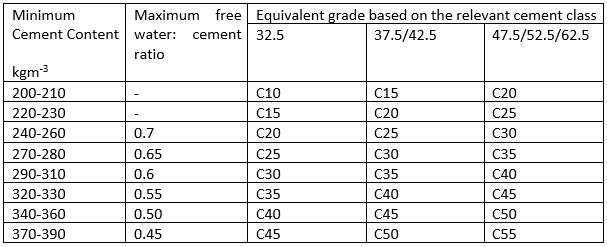Concrete is weak in tension primarily due to its heterogeneous composition, which includes the cementitious matrix, aggregates, and a vulnerable Interfacial Transition Zone (ITZ) between them.
The ITZ, a micro-region surrounding coarse particles, becomes the primary source of cracks under tensile strain, resulting in concrete’s significantly lower tensile strength compared to its compressive strength.
Concrete is a heterogeneous material composed of three major phases: cementitious matrix, aggregates, and the Interfacial Transition Zone (ITZ) in between the cementitious matrix and the particles. The transition zone of concrete is a tiny region around coarse particles that are 10–50 mm thick.
This is the framework made by large ettringite and calcium hydroxide crystals, which are both crystalline results of hydration near large aggregates. The most vulnerable link in the chain is the interfacial transition zone. Because of the interfacial transition zone, concrete breaks at a far lower stress level than either of the two primary components.
In a uniaxial compression test, aggregate and hydrated cement paste or mortar are usually elastic until they break. Concrete, on the other hand, is not elastic. Tension makes the matrix cracks grow bigger until they meet the cracks that start in the interfacial transition zone. The material ruptures when the crack network becomes continuous.
Energy is needed to make and spread matrix cracks when they are under compression. Under tensile strain, on the other hand, cracks spread quickly and at much lower stress levels. This is why concrete becomes brittle in tension while remaining rather resistant in compression. As a result, the tensile strength of concrete is significantly lower than its compressive strength. Hence, as a counterweight, concrete has been reinforced to prevent crack formation.
Table of Contents
Factors affecting the strength of concrete
Age at test
It takes a concrete mix made with certain materials and certain proportions a long time to build up strength. Although the strength is tested at 7 days, 14 days, 28, 90 days, etc., in most specifications the target strength is defined as the strength at the age of 28 days.
Curing condition
The temperature and humidity conditions during curing affect the strength development of concrete prepared with all types of Portland cement. Higher temperatures accelerate the chemical reaction and hence the pace of strength growth; however, in order to reach higher strengths at later ages, water loss from the concrete must be avoided. For testing purposes, concrete test specimens are immersed in water at a constant temperature. 7-day curing typically contributes to 65–70% of total compressive strength.
Cement content
It is the amount of cement contained in one cubic meter of fresh, adequately compacted concrete, expressed in kilograms per cubic meter. A minimum cement content is essential for a long service life of the structure under specific exposure conditions. Cement content of more than 550 kgm-3 should not be utilized unless special details are provided in the design due to the increased danger of cracking owing to drying shrinkage in sections with less thickness or thermal stresses in the sections with higher thickness. This will also induce the possible damage caused by the alkali-silica reaction.
Also read this: How Many Bags of Concrete in a Yard? A Practical Guide
Type and strength class of cement
Concretes with different rates of strength development are characterized by the type and strength class of cement. Generally, the chemical reaction in class 52.5 Portland cement begins faster than in class 42.5. Consequently, the early strength of the higher strength class will be high.
Cement strength variation
The standard deviation of the strength of typical concrete cubes at 28 days created with Portland cement class 42.5 in various tasks is around 5 N/mm 2, whereas the standard deviation owing to cement variability from a specific task is approximately 3 N/mm 2.
Free water/cement ratio
The total moisture content in a concrete mix is from the water absorbed by the aggregate to get it to a saturated surface-dry condition together with the free water required for the hydration process and fresh concrete workability. Practically, the aggregates are wet most of the time and include both absorbed and free surface water. Hence, the amount of water required at the mixing is less than the amount of free water required. The workability of concrete is heavily influenced by its free-water content.
For dry aggregates with varied absorption rates, the concrete workability will be different even with the same total water content. The proportion of the mass of free water to the mass of cement in concrete, mortar, or grout expressed as a decimal is known as the free water/cement ratio. The free water/cement ratio affects the concrete strength. Maintaining the free water/cement ratio to the lowest compatible value helps in generating properly compacted concrete while minimizing segregation or bleeding, which causes strength reduction.

Aggregate type and grading
The compressive strength of concrete is significantly influenced by the source and type of aggregates. Uncrushed aggregates use less water with respect to crushed aggregates in order to produce concrete with the same workability. If the aggregate’s maximum size is smaller, more water is required. As a result, uncrushed coarse aggregates (smooth and rounded) produce a lower strength of concrete than crushed coarse aggregates. The type of fine aggregate, the maximum size of the aggregates, the grading, texture, and shape of the concrete, and other factors have little effect on the compressive strength of the concrete.

Type of mixing
The compressive strength of the concrete is not directly affected by the type of mixer. However, the amount of cement needed for a specific free water/cement ratio is influenced by the type of mixer as some mixers require a considerable degree of workability in terms of efficiency in operation. Hand-mixed concrete, on the other hand, is likely to have a lesser strength compared to machine-mixed concrete of the same proportions.
Related: BASICS OF STRUCTURAL DESIGN











